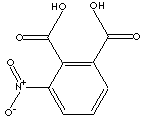PRODUCT IDENTIFICATION

3-NPA; m-Nitrophthalic acid;
CLASSIFICATION
PHYSICAL AND CHEMICAL PROPERTIES
AUTOIGNITION
NFPA RATINGS
REFRACTIVE INDEX
APPLICATIONS
APPEARANCE
98.0% min
210 C min
0.1% max
|
|
|
| 3-NITROPHTHALIC ACID | ||
|
PRODUCT IDENTIFICATION |
||
| CAS NO. | 603-11-2 |
|
| EINECS NO. | 210-030-8 | |
| FORMULA | O2NC6H3(COOH)2 | |
| MOL WT. | 211.13 | |
| H.S. CODE |
| |
| TOXICITY | ||
| SYNONYMS | 3-Nitro-1,2-benzenedicarboxylic acid; | |
|
3-NPA; m-Nitrophthalic acid; |
||
| SMILES |
|
|
|
CLASSIFICATION |
|
|
|
PHYSICAL AND CHEMICAL PROPERTIES |
||
| PHYSICAL STATE | slightly yellow crystalline powder | |
| MELTING POINT | 210 - 216 C (Decomposes) | |
| BOILING POINT | ||
| SPECIFIC GRAVITY | ||
| SOLUBILITY IN WATER | ||
| pH | ||
| VAPOR DENSITY | 7.3 | |
|
AUTOIGNITION |
||
|
NFPA RATINGS |
Health: 1; Flammability: 0; Reactivity:0 | |
|
REFRACTIVE INDEX |
| |
| FLASH POINT | ||
| STABILITY | Stable under ordinary conditions | |
|
APPLICATIONS |
||
| 3-Nitrophthalic acid is used as an intermediate for the synthesis of corrosion inhibitors, medicines (Candesartan) and agrochemicals. | ||
| SALES SPECIFICATION | ||
|
APPEARANCE |
slightly yellow crystalline powder | |
| PURITY |
98.0% min | |
| MELTING POINT |
210 C min | |
| ASH |
0.1% max | |
| TRANSPORTATION | ||
| PACKING | 25kgs in fiber drum | |
| HAZARD CLASS | ||
| UN NO. | ||
| OTHER INFORMATION | ||
| Hazard Symbols: XI, Risk Phrases: 36/37/38, Safety Phrases:24/25 | ||
| GENERAL DESCRIPTION OF PHTHALIC ACID | ||
| Phthalic Acid, also called Benzenedicarboxylic Acid with formula C6H4(COOH)2, is the name of any of three isomers. The ortho form (1,2-benzenecarboxylic acid) is called simply phthalic acid. It is a white crystals decomposing at 191°C and slightly soluble in water and ether. This compound is mainly produced and marketed in the form of its anhydride produced by the oxidation of orthoxylene and naphthalene. Its wide application is based on the ortho related carboxylic acid groups as their dehydration is highly reactive with broad processing conditions to produce various downstream products. It is used to make simple esters widely used as plasticizers. It is used as in making unsaturated polyester resins, alkyd resins, polyester polyols, dyes and pigments, halogenated anhydrides, polyetherimide resins, isatoic anhydride and insect repellents. The meta form is isophthalic acid (1,3-benzenecarboxylic acid). It is a white crystals subliming at 345°C slightly soluble in water, alcohol and acetic acid (insoluble in benzene). It is obtained by oxidizing meta-xylene with chromic acid, or by fusing potassium meta-sulphobenzoate, or meta-brombenzoate with potassium formate. IPA has excellent performance characteristics in coatings including excellent hardness, corrosion and stain resistance, hydrolytic stability of coatings and gel coats, excellent thermal stability and low resin color. It is a key ingredient in FRP markets for such products as marine, automotive, and corrosion resistant pipes and tanks. Polyesters containing isophthalic acid are also used extensively in industrial coatings applications for home appliances, automobiles, aluminum siding, and metal office furniture. It used as an intermediate for polyesters, polyurethane resins, plasticizers. The para form, known as terephthalic acid (1,4-benzenecarboxylic acid) is a combustible white powder insoluble in water, alcohol and ether; (soluble in alkalies), sublimes at 300°C. It can be produced by oxidizing caraway oil, a mixture of cymene and cuminol or by oxidizing para-diderivatives of benzene with chromic acid. TPA has been used mainly as a raw material of polyester fiber but lately it has been exploited for various uses such as non-fiber field, PET-bottle, PET-film and engineering plastics and as poultry feed additives. Phthalic acid derivatives are also widely used to make dyes, medicine, and synthetic perfumes, pesticides, and other chemical compounds. | ||
|
|
|